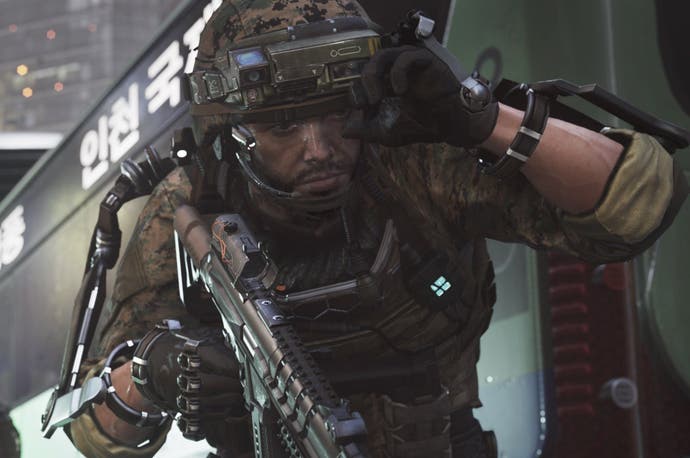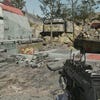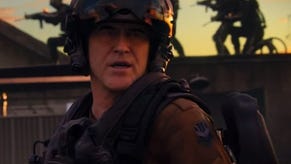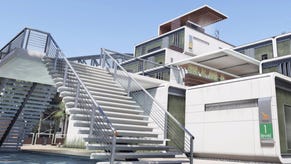Digital Foundry: Hands-on with COD: Advanced Warfare multiplayer
Can Sledgehammer hit the 60fps target?
As played at this year's Gamescom and EGX on Xbox One, multiplayer in Advanced Warfare is a very different beast to the work-in-progress Seoul campaign mission shown at Microsoft's E3 event. Set across a broad rotation of maps, from the snowy Biolab complex to the futuristic gloss of Defender, it's clear changes were needed to boost multiplayer performance above the variable 30-60fps seen in solo play. But in the visual sense, what has changed in order to hit the all-crucial 60fps target, as demanded by the series' competitive players?
Running at a native 1600x900 at both events (a boost from the E3-era 882p), little has changed to Xbox One's rendering setup for multiplayer, suggesting this number is a lock for all modes in the final release. That said, we catch one difference from its single-player mode: the HUD. While the Seoul campaign level flaunted a stylish HUD-free design, displaying ammo details on the gun itself, the multiplayer reverts to a more traditional overlay design.
Opaque panels now line the screen's edges, showing the map, bullet counter and target points - rendered in the same pass as the actual gameplay. To our pixel count, these element are upscaled from the same 900p base resolution as the core gunplay - a mix-up for a series which, until now, delivered HUDs at the highest resolution possible, independent of the 3D rendering side. The net result is a more cluttered screen than the slick campaign-side design, but it's also practical choice, given the sheer amount of info needed here.
Having tested the game extensively at both conventions, the Gamescom build is perceptibly the same as that of the EGX one. Texture detail is a complete match when compared at common spawn points, and likewise for shadow quality, the dynamic lighting model and the use of screen-space reflections (in heavy use around the futuristic Defender level).
Alternative analysis:
- Call of Duty: Advanced Warfare - Xbox One multiplayer frame-rate tests (60fps, play at 2x speed)
- Call of Duty: Advanced Warfare - Xbox One multiplayer frame-rate tests (60fps, optimised for mobile)
But what about performance? The multiplayer mode brings colossal improvements over the taxing Seoul stage shown at this year's E3. After concerns it might be dragged down by the same visual ambition, we instead get a mostly solid 60fps experience. Even with 16 players tussling for map domination on Ascend's wave-wracked shores, Sledgehammer Games' engine holds to the 60fps line very firmly indeed. With only two cases of singular dropped frames, this multiplayer build is in an encouraging state as is, though we note that when the engine is (very rarely) taxed to its limits, an adaptive v-sync kicks in, producing screen tear.
The good news? After analysing over 23,000 frames of footage we record only three actual torn frames - essentially invisible during the run of play. The use of alpha appears to be a weakness here, with v-sync breaking when stood at the centre of a grenade's splash range with shader effects on the go. It's a tricky one to catch by eye, but as a worst-case scenario it allows the engine to uphold controller response on the rare occasions rendering spills over budget.
With such an impressive turnout for multiplayer, the suspicion is that the visual splendor of the campaign is curtailed in some way. From the dynamic lighting model to the effects work, we looked for any signs of concession - and while there is one big change, it's hardly a show-stopper. Put simply, the full-screen motion blur effect once used for camera whip-pans is no longer, leaving a clear, unprocessed image on making sharp turns.
While this appeals to the game's competitive slant, by keeping each frame clear for eagle-eyed twitch-shooters, the change no doubt improves performance. That said, we do see a cheap makeshift alternative creeping in, with a light blur effect appearing towards the screen's edges when jet-boosting between rooftops. Nevertheless, we're left with a far less cinematic look compared to the campaign.
Per-object motion blur makes a return too, albeit also in a simpler form. A heavily banded implementation is seen across melee flails especially, but it's no longer applied to ally players scuttling past, or on hands during reload animations. It's lower in quality and greatly minimised in use from the E3 campaign - though we do still get the stylish 'ripple' shader effect behind jet-boosting allies.
Advanced Warfare's lighting model remains unchanged, with ambient occlusion still in place, plus the very same quality of shadows. In daylight, it's curious to see an interlacing effect on the edges of real-time shadows, particularly for stages like Ascend and Biolab. It's a slight distraction and something we also detect in the campaign. That said, the darkened, interior settings of the single-player jaunt through Seoul largely avoid the effect.
Some slack is cut when designing the multiplayer levels, too, with its relative lack of cut-scenes, facial motion capture, and scripted in-engine events. This certainly goes some way towards freeing up the Xbox One's resources - focusing on a 60fps target more effectively, with 16 players being the only variables Xbox One needs to cater for.
It's a tough act to follow, after all. The campaign build has mechs trundling across Seoul's cracked streets, drone swarms flying overhead, exploding vehicles and AI characters adapting to your every move. But the competitive maps, despite being built to the flavour of the solo levels, are relatively static and sparse in design. Save for the crashing waves on the Ascend stage's shoreline, there's little background action to impact the run of play.
A reliance on fewer moving parts, plus the pared back motion blur, goes a long way to explaining the multiplayer mode's improved 60fps performance. But given that our last contact with Advance Warfare's campaign dates all the way back to E3, it's likely ample time has been spent optimising all modes alike on Xbox One.
Added to that, we've yet to see the impact of Microsoft's June SDK update on the campaign - freeing up precious GPU resources on Xbox One. Opening another avenue for frame-rate boosts in the final release, we hope Sledgehammer Games avoids any cuts to the grand effects-work that defined its single-player reveal. We're on the home stretch to the 4th November release now, meaning all will be revealed soon - including the state of the unseen PS4 version.





























